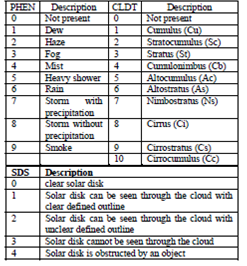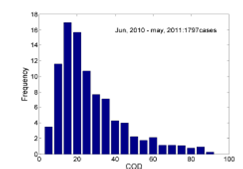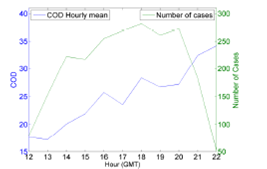Services on Demand
Journal
Article
Indicators
-
 Cited by SciELO
Cited by SciELO -
 Access statistics
Access statistics
Related links
-
 Similars in
SciELO
Similars in
SciELO
Share
Revista Boliviana de Física
On-line version ISSN 1562-3823
Revista Boliviana de Física vol.20 no.20 La Paz 2012
One year of Cloud Optical Depth measurements with sunphotometer in Camagüey, Cuba.
Boris Barja(1), Yasmine Benouna(2), Carlos Toledano(2), Juan Carlos Antuña(1), Victoria Cachorro(2), Carlos Hernández(1), Ángel de Frutos(2) and René Estevan(1).
(1)Atmospheric Optics Group of Camagüey, Carretera a Nuevitas km 7 ½ Camagüey, CUBA Tel: +53 32262397, e-mail: bbarja@gmail.com
(2) Atmospheric Optics Group, University of Valladolid, Valladolid, Spain
SUMMARY
One year of Cloud Optical Depth (COD) measurements obtained with the radiometer (sunphotometer Cimel CE – 318) are presented. As the first step a validation method is proposed in order to confirm the cloud in the measurement. This method is based in the cloud information derived from the actinometrical observations and radar data. In the second step of the work, the statistical results from the one year of the COD measurements in Camagüey are analyzed. The results show the high quality of COD measurements at Camagüey. The analysis of the COD frequency shows one peak close to 15. Similar behavior occurs each month. The mean COD average value for the entire period is 27.2, with a standard deviation of 17.3. The mean monthly minimum and maximum value of COD occur in December and May, respectively. The diurnal cycle of the mean hourly COD values shows an increase in the afternoon hours. In the afternoon the number of cases measured decrease. The preliminary results shown in this paper constitute the first report of such measurements in the country.
Key words: Cloud optical depth (COD), sunphotometer, Camagüey, Cuba.
INTRODUCTION
Clouds are a key point in the climatic system. They interact with the solar and terrestrial radiation and in turn are essential in the determination of the atmospheric radiation budget. The intensity of these processes is related with the optical and microphysical properties of the clouds. Thus, the study of the cloud optical properties is very important in order to understand their behavior and their climatic effect. These properties are identified by the optical depth (COD), singe scattering albedo ( ), and the asymmetric factor (g) of the cloud drops. Cloud optical depth (COD) is a fundamental value in the determination of the radiative energy balance in the Earth. Nevertheless, this property is very difficult to measure with ground remote sensing technique using the traditional methods. Better representation of the COD in the atmospheric general circulation and climatic models is a challenge in the atmospheric sciences. By those reasons it is necessary the increase of the COD measurement sites and the exactitude of the measurement.
There are two principal operational networks with the primary objective of the measurements of the cloud characteristics from the ground: the first one is of the Atmospheric Radiation Measurement Program (ARM) (Stokes and Schwartz, 1994), the second one is the network for measurement of clouds (Cloudnet) (Illingworth et al., 2007). But the number of the measurement sites of these networks is limited in order to obtain ground based global scale measurements.
Aerosol Robotic Network (AERONET) is designed for the measurements of the optical and microphysical properties of the aerosols (Holben et al., 1998). AEROENT have more than 250 measurement sites over the world with sun radiometers that make sun direct irradiances and sky radiance measurements. When the cloud is in the instrument field of view the measurement is not useful for the aerosols properties determination. Then it is possible to set the sunphotometer to the cloud mode (Chiu et al., 2010), completing a set of the radiance measurements in the zenith to obtain COD values.
In the Atmospheric Optics Group of Camagüey (GOAC) a sunphotometer CIMEL CE-138 was installed. This instrument is part of the collaboration between the Atmospheric Optics Group (GOA) from Valladolid University, Spain and GOAC. Aerosols and clouds measurements with sunphotometer began in October 2008 and June 2010, respectively.
The objective of the present work is to evaluate in a first approach the strength of the COD measurements from the sunphotometer. The question to answer is: Does the COD sunphotometer measurement match the actinometric cloud reports? Reported cloud information in the hourly actinometric measurements is used in the validation algorithm. The second objective of the work is to obtain a preliminary COD statistics for non precipitating clouds during the first year of measurements at Camagüey.
INSTRUMENT AND METHODS
The data employed in the present work is from the sunphotometer Cimel CE-318 installed in Camagüey (21.42º N, 77.84º W, 128 m asl), Cuba. AERONET employed this radiometer for the measurement of sun direct irradiance and sky radiance with a field of view of 1.2º in the wavelengths of 340 nm, 380 nm, 440 nm, 675 nm 870 nm, y 1020 nm. (Holben et al. 1998).
When the cloud is in the instrument field of view the measurement is not useful for the aerosols properties determination. Chiu et al. (2010) proposed recently the use of these conditions to make 10 radiance measurements in the zenith in each wavelength, named cloud mode. This is based in the suggestion of the use of two wavelength measurements in the red and near infrared spectrum to retrieve COD values over the vegetated surface (Chiu et al., 2010).
The method for the COD determination employed in AERONET is explained in details by Chiu et al., (2010). Nevertheless some points are given here. There is no one to one relationship between zenith radiances and COD. So, two wavelengths radiance measurements (470 nm and 879 nm) are employed to reduce the ambiguity. With the radiance in these two wavelengths, some radiative transfer calculations, and satellite data the COD value is obtained (Chiu et al., 2010). The reported COD value is the average of the 10 instantaneous values. The dataset used in the present study is from June 2010 to May 2011, with 2277 values.
An algorithm is proposed to evaluate the COD measurements. This approach is intended to determine the correct COD measurements. The evidences of this correctness is obtained from the reports on clouds in the hourly actinometric observations.
The characteristics of the cloudiness used in the algorithm are: the solar disk state (SDS), covered sky fraction by cloud (SFT), covered sky fraction by low cloud types (SFL), atmospheric phenomena occurring at the time of observation (PHEN), cloud types present in the sky (CLDT), cloud types present in the zenith direction (CLDZ). The factors PHEN, CLDT, CLDZ and SDS are described in Table 1. Note that the actinometric measurements are made in the direction of the Sun and radiometric observations are in the zenith direction. The covered sky fractions are evaluated in base to 10 parts.
The steps of the algorithm are described below:
1. Evaluate the direct coincident actinometric report with COD measurement, by times difference ( t) of 10 minutes.
2. If the first step is satisfied the cloudiness characteristics are evaluated.
2.1.If SDS is different of 1, the sunphotometer can be decided to enter in the `cloud mode´. But it does not mean that there are clouds in the zenith. Thus it is necessary to evaluate the SFT, SDL, CLDT and CLDZ..
2.1.1.For the SDS from 2 to 4.
2.1.1.1.If SFT is between 1 and 3 and the COD measurement time is between 15:00 GMT and 19:00 GMT, the COD is selected as correct.
2.1.1.2.If SFT is between 4 and 10 and the SFL is equal to SFT, the COD is selected as correct.
2.2.Always the COD values are compared with CLDT and CLDZ to evaluate the correspondence of the value.
Table 1. Parameter codification for atmospheric phenomena (PHEN), cloud types (CLDT and CLDZ) and solar disk stateSDS.

3. If the first step is not satisfied, it is necessary to compare cloudiness characteristics from the actinometric observations before and after the COD measurement time.
3.1.If the cloudiness characteristics indicative of the presence of cloud (CLDT>5, CLDZ>0, SFL>4, PHEN>4) are similar in both actinometric observations, the COD is selected as correct.
3.2.CLDT and CLDZ are compared in both actinometric observations to evaluate the COD value with the limits shown in the point 2.2.
A set of COD values is obtained with the COD selected as correct. The features of the COD true values are analyzed for the complete period from June 2010 to May 2011, as well as in monthly and hourly basis.
RESULTS AND DISCUSIONS
The set of original COD measurements in the period consists of 2277 values. After applying the evaluation algorithm 2250 COD values are selected as correct, representing the 98.8 % of the cases. Only 25 cases were rejected and 2 cases can not be compared because the actinometric measurements were not conducted. The rejected cases were related with low values of COD and the absence of cloud in the zenith. It can be seen the agreement between the sunphotometer COD measurements and the actinometric reports of clouds.
The extreme values of COD, values lower than 3 and higher than 90, are discarded from the dataset, following the criteria of Chiu et al., (2010). A total 1797 COD values are selected after the application of this criteria, representing a 79.9 % of the correct values. This dataset is used for the statistical analysis. The mean value of COD is 27.2, with a standard deviation of 17.3.

Figure 1. COD frequency distribution for the period from June 2010 to May 2011, in Camagüey
In the Figure 1 the COD frequency distribution is shown with an interval of 5 units of COD. The maximum frequency of 17 % is found in the interval centered at 15. The COD frequency values increase from COD value 3 to the maximum in 15 and then the values decrease for higher values of COD. This result shows a similar frequency distribution than the report from Chiu et al., (2010) for three years of data from November, 2004 to June, 2008 at the ARM measurement site of Oklahoma in the United States of America. The authors show for Oklahoma maximum frequency of 24 % at COD value near to 23. Also, they show the increase of the frequency from minimum values of COD to 23 and then the frequency values decrease for higher values of COD (Chiu et al., 2010). The results for Camagüey and Oklahoma sites show similar behavior of the COD, with different magnitude values. The data sets for both sites have some differences, based in the extent of the datasets and different geographical location.
Figure 2 shows the behavior of the monthly mean of COD values and the number of cases in each month for the measurement period. The COD monthly mean maximum value of 34.2 is in the month of May, 2011. The minimum value of COD of 19.8 is in December, 2010. The number of cases reaches their maximum of 274 and minimum of 99 in October, 2010 and February, 2011, respectively. This result shows May with the maximum monthly mean value
The mean COD daily behavior is shown in the Figure 3. The COD hourly mean values increase with the hour during the day. Maximum value of COD hourly mean value is 34.2 at the 22 GMT; the minimum value of 17.2 is at 13 GMT. This result is in relation with the development of the cloudiness during the day. The number of cases has a maximum of 282 at 18 GMT. In the first and last hour there are the minimum values of number of cases. At these times in some months of the year there are no measurements with the sunphotometer.
CONCLUSIONS
This is the first report on cloud optical depth ground measured in our country. The COD frequency distribution shows a maximum at the interval centered in 15. The frequency distribution of COD agrees with other reports. There is a monthly COD maximum of 34.2 in May. Nevertheless, the maximum value of the number of cases occurs in October. Monthly and hourly mean values of COD show the concordance with the natural behavior of the clouds in our region.

Figure 2. COD Monthly means for the period from June 2010 to May 2011.

Figure 3. COD Hourly means for the period from June 2010 to May 2011.
REFERENCES
1.- Chiu, J. C., C.-H. Huang, A. Marshak, I. Slutsker, D. M. Giles, B. N. Holben, Y. Knyazikhin, and W. J. Wiscombe (2010), Cloud optical depth retrievals from the Aerosol Robotic Network (AERONET) cloud mode observations, J. Geophys. Res., 115, D14202, doi:10.1029/2009JD013121. [ Links ]
2.- Holben, B. N., Eck, T. F., Slutsker, I., Tanré, D., Buis, J. P., Setzer, A., Vermote, E. F., Reagan, J. A., Kaufman, Y. J., Nakajima, T., Lavenu, F., Jankowiak, I., and Smirnov, A. (1998), AERONET: A federated instrument network and data archive for aerosol characterization, Remote Sens. Environ., 66, 1–16. [ Links ]
3.- Illingworth, A. J., et al. (2007), Cloudnet: Continuous evaluation of cloud profiles in seven operational models using ground based observations, Bull. Am. Meteorol. Soc., 88, 883–898. [ Links ]
4.- Stokes, G. M., and S. E. Schwartz (1994), The Atmospheric Radiation Measurement (ARM) Program: Programmatic background and design of the cloud and radiation test bed, Bull. Am. Meteorol. Soc., 75, 1201–1221. [ Links ]














